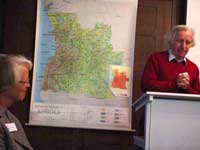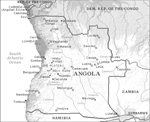David
Birmingham:
Wagon Technology,
Transport and Long-distance Communication
in Angola 1885-1908
 |
In
the 1820s a wagon train drawn by oxen and/or horses left Switzerland
to cross the Alps, the Austrian plains, the Carpathians, and the Ukrain
to set up a Swiss colony which lasted more than a century on the shores
of the Black Sea. In the 1830s several hundred Dutch-speaking farmers
loaded their wives and children and possessions on to 24-ox wagons and
drove them through the Karoo and the Kalahari in search of freedom from
British rule. In the 1850 great trains of wagons set off from beyond
Chicago across the great American plains and eventually reached the
Pacific coast of Oregon. In the 1890s all these things came together
when a Swiss wagon engineer became the local purchasing agent for the
great Chicago wagon-building firm of Studebaker and supplied wagons
and wagon repairs on credit to the Boers who had crossed the Thirstlands
to reach the Angolan plateau. His name was Chatelain and his wagon workshop
was at Kalukembe. The paper addresses, inter alia, the question of the
relative cost effectiveness of ox-wagons and columns of human porters
- some of them slaves - during the rubber boom in Angola with comparisons
on cost, time, insurance, safety and reliability. The wagons were also
used to transport copper aire for setting up the overland telegraph
wires, though Chatelain said that runners could often carry messages
more quickly and reliably than the wire service. The wagons were also
used to supply the railway builders - though Portuguese army officers
claimed that head-porters were faster and more efficient than the embryonic
and heavily subsidised first railways. |


